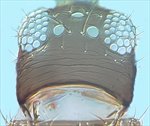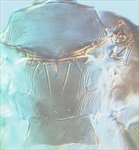Generic diagnosis
Female macropterous. Head slightly wider than long, interantennal projection relatively wide; maxillary palps 3-segmented; eyes without pigmented facets; ocellar setae I present; setae III long, at or posterior to tangent of hind ocelli posterior margin; three or five pairs of postocular setae. Antennae 8-segmented, segment I without paired dorso-apical setae, III and IV with sense-cones forked, III–VI with some microtrichial rows on both surfaces. Pronotum wider than long, two pairs of long posteroangular setae, three pairs of posteromarginal setae; one pair of anteromarginal setae sometimes well-developed. Mesonotum weakly sculptured, median pair of setae near posterior margin; campaniform sensilla present or absent. Metanotum almost smooth medially; median pair of setae at anterior margin; campaniform sensilla absent. Fore wing first and second veins each with setal rows complete; clavus with five veinal and one discal setae; posteromarginal fringe cilia wavy. Prosternal ferna continuous; basantra membranous, without setae; prospinasternum broad and transverse. Mesosternum with sternopleural suture completes; endofurca with spinula. Metasternal endofurca without spinula. Tarsi 2-segmented. Tergites without craspeda; IV–VIII with paired regular ctenidia, on VIII anterolateral to spiracles, S3 setae at posterior margin far mesad of posterior angle; tergites V–VIII with S2 setae small; VIII with comb sparse or absent; IX with two pairs campaniform sensilla. Sternites without craspeda; III–VII with three pairs of posteromarginal setae, II with two pairs; laterotergites without discal setae.
Male similar to female; tergite IX without short stout setae medially; sternites III–VII each with a large pore plate.
Biological data
The three Australian species are known to have specific host associations (Gillespie et al., 2002), but little is known of the biology of the three species recorded from China.
Distribution data
Of the six species in this genus, three are known only from Australia and three from southeast Asia.
Nomenclatural data
Parabaliothrips Priesner, 1935: 125. Type species Parabaliothrips takahashii Priesner, 1935, by original designation.
This genus includes six species (ThripsWiki, 2020), of which three are recorded from China:
coluckus (Kudo, 1977: 5). (Krasibothrips)
grandiceps Priesner, 1935: 126.
takahashii Priesner, 1935: 125.
Relationship data
Thripidae sub-family Thripinae: this is a diverse group involving more than 230 genera. This is one of nine genera placed in the Frankliniella-group. It is distinguished particularly because the tergal ctenidia terminate at the lateral marginal setae, in a more anterior position than in other members of the Frankliniella-group (Mound, 2002). However, Wang et al. (2019) suggested that the three species from Australia might bot be closely related to the species from Asia.
References
Gillespie, PS, Mound LA & Wang, CL (2002) Austro-oriental genus Parabaliothrips Priesner (Thysanoptera, Thripidae) with a new Australian species forming male aggregations. Australian Journal of Entomology 41: 111–117.
Mound LA (2002) The Thrips and Frankliniella genus groups: the phylogenetic significance of ctenidia. Pp. 379–386 in Marullo R & Mound LA [eds] Thrips and Tospoviruses: Proceedings of the 7th International Symposium on Thysanoptera. Australian National Insect Collection, Canberra.
ThripsWiki (2018). ThripsWiki - providing information on the World's thrips. <http://thrips.info/wiki/Main_Page>
Wang ZH, Mound LA & Tong XL (2019) Phylogenetic relationships within the Frankliniella genus-group based on morphology, with a revision of Iridothrips (Thysanoptera, Thripidae). Zootaxa 4651 (1): 141–154.



